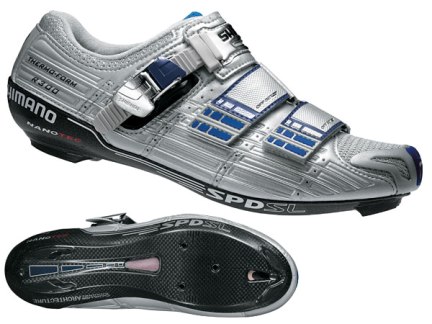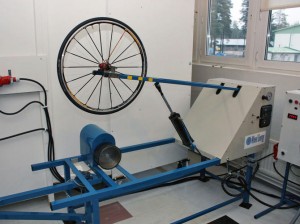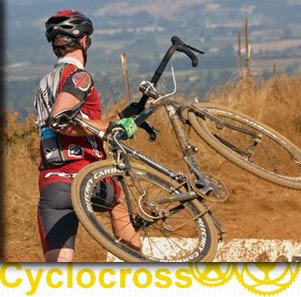This is a Glossary of sorts I’ve compiled over the years that will be occasionally updated. Think of it as your Bike Dictionary. Bookmark it and use it often. Don’t know what something means? Look for it here. Can’t find it? Write us or leave a comment and we’ll create a new entry. We hope this is a great service that we can all keep improving. Enjoy!
Sorry, I’m not going to even try to keep this in alphabetical order…
Road Bike Terms-
Cadence: The revolutions per minute (rpm) of your cranks as propelled by your legs. Often used as a measure of efficiency (higher cadence is usually deemed more efficient) or as a guide for gear selection. In road cycling for the last decade, 90 rpm is considered a benchmark cadence.
Compact (double) Crank: The alternative to standard double or triple crankset. The compact double crankset has two chainrings of smaller diameter than a standard double; usually 50 teeth (50t) and 34 or 36 teeth (34t) instead of 53 and 39 teeth. This lower and broader range of gears provides a wider variety of ratios and easier climbing gears. Compared to a traditional triple, a compact offers smoother front shifting and may be lighter; but is commonly geared slightly higher.
Components: Catch-all term for brakes, shifters, derailleurs, gears, chains etc.
105, Ultegra, Dura Ace: These are currently three top-tier levels of Shimano’s road components – Dura Ace being the highest; professional level components. Since Shimano holds majority market-share for components in the bike industry – these are considered the benchmarks for quality and performance at their given levels.
TT: Short term for Time Trial – an individual “race against the clock” usually involving more aerodynamic equipment than is commonly found in traditional road racing. Often augmented by ITT (individual time trial) and/or TTT (team time trial).
Sizing: Quick, approximate process to establish an ideal frame size and safe riding position. Not as detailed as fitting. Commonly a service given away for free with a new bike (but often referred to as fitting). Think of sizing as going to a clothing boutique and the associate recommending sizes to try on.
Fitting: Detailed analytical process of adjusting a bicycle and the rider’s position on that bicycle to improve comfort, efficiency, power, and reduce likelihood of injury due to repetitive motion. Good fitting services are more like going to a tailor for a suit than anything. Evaluation of individual physiology, injury history, riding habits, and goals must be a part of the process to insure good results. Quality fitting services are commonly not found “given away” for free.
Triple (crank): A common crankset on mountain bikes and hybrids, the triple is also found on road touring bikes and many recreational and enthusiast road bikes. It gets it’s name from the three chainrings found on it; providing a low, medium, and high range of gears. The smallest, inner-most chainring is often referred to as the “granny-gear” and is your lowest range of gears for climbing.
SIS: Shimano Indexing System. This is the trademark used to identify Shimano’s indexed shifting system (think of it like pre-set stations on your radio – push the button and it goes there). Indexed shifting is the norm now and replaced “friction” shifting which was more like older style analog radios where you turn the dial until it sounds good. Friction shifting is still an option, but not easy to find and only somewhat common on time-trial and touring bikes.
BB-30: Bottom Bracket 30 – refers to an open-source standard pioneered by Cannondale and widely accepted in the industry involving a larger 30 mm crank spindle (axle) and similarly oversized bearings which are pressed directly into the frame rather than threaded into the frame as has been the traditional method. Other standards of oversized bearing/spindle or press-fit bearings exist and are usually not interchangeable. Examples: BB-90, BB-91, BB-86
Clincher: Now more common than the tubular(sew-up) tire – but this was not always the case. The clincher tire more closely resembles automobile tires in its formation, involving a “bead” of various materials designed to interface with a “hook” in the clincher rim to old the tire firmly on the rim without adhesives and encase the inner tube. Clincher tire quality has increased immensely adding performance and reducing weight in the last couple of decades. It is now the norm for training and amateur racing due to it’s lower cost and ease of maintenance and replacement.
Tubular(sew-up): The same and different. First: either of these refers to a tire that must be glued or otherwise adhered to a rim as opposed to the now common “clincher” variety. Sew-up tires are the oldest variety and refer to a tire with an innertube (usually latex) sewn into the body of the tire. Tubular is the umbrella term covering sew-ups and tires with other construction methods which still must be adhered to the rim surface. Tubular tire/rim combinations are not interchangeable with clincher tires and rims. They can often provide lighter weight, better comfort, and better cornering but are also usually more expensive and difficult to install. Tubular tires are difficult to fix when punctured. Tubular tire gluing and installation can have catastrophic results when done wrong and should not be taken lightly. We recommend installation by a very experienced professional.
MTB Terms
29er: Larger diameter mountain bike wheel standard which has actually been around for quite a while but is finally gaining wide-spread acceptance and support. Finally popularized by Gary Fisher with his bike brand, these wheels are taller than the standard 26″ wheels traditionally used. Employing the 700c rim diameter most commonly found on road, touring, and hybrid bicycles; the 29er is promoted as being a more efficient wheel size for rolling over obstacles and maintaining speed and momentum. The down sides are often additional weight and reduced agility.
2×10: Newly introduced gearing standard for mountain bikes mirroring a popular road bike standard, pioneered by component manufacturer SRAM and soon after endorsed by Shimano. The 2×10 involves a gear cluster of 10 cogs on the rear wheel and crankset of 2 chainrings. Traditionally, mountain bikes have had 3 chainrings and between 7 and 9 cogs.
LX, XT, XTR: These have long been the three top-tier levels of Shimano’s mountain components – XTR being the highest; professional level components. Since Shimano holds majority market-share for components in the bike industry – these are considered the benchmarks for quality and performance at their given levels. LX was recently replaced by “SLX”
Sag: Term referring to the movement of the suspension system on a mountain bike when a rider sits on the bike. Sag is ideal and part of the design parameter, allowing the system to adapt better to the terrain than a system without sag. A suspension system is often designed to have a sag amount of 15-25% of the total travel of the system.
Tubeless: A tire and rim system designed to work without the use of the more common inner tube. Often involves a sealed rim or rim-strip, special air valve, and tire sealant or special tire which is less air-permeable. Tubeless systems are becoming more common but are still only found at the higher ends of the product offerings. They allow the use of lower tire pressures providing better traction and reduced chance of flatting from lower pressure (pinch flats). The tires can be more difficult to mount on the rims because of the necessity of a tight fit to hold air. The easiest way to fix a puncture on a tubeless tire system is to install an inner tube – so carry a spare.
UST: Mavic’s tubeless standard “Universal Standard for Tubeless” (http://www.mavic.com/mtb/technologies/UST.1.9405.aspx). While this system is touted as a “universal standard” it is not necessarily compatible with all tubeless systems.
Compression: Term that refers to a suspension system coming under load and into a compressed state. Also used to refer to the compression adjustment on a suspension system and controlling how quickly or slowly a system compresses thereby fine-tuning the system to a rider’s weight and riding style.
Rebound: Term that refers to a suspension system returning from it’s loaded, “compression” state to it’s unloaded state. Also used to refer to rebound adjustment on a suspension system and controlling how quickly or slowly a system rebounds thereby fine-tuning the system to a rider’s weight and riding style.
General Terms
True: Term used to describe a rim’s alignment to itself. A straight rim is “true”. A “wobbly” rim is “out-of-true”. To repair an out-of-true wheel you take it to a shop to be “trued”. Wheel truing is an art best performed by an experienced mechanic and when well done improves the life-span and performance of your wheels.
Dish: Term used to describe a rim’s alignment to the centerline of the wheel. A rim that is centered is “in dish”. A rim that is of center is “out of dish”. To repair an out of dish wheel you take it to a shop to be “dished”. This is an integral part of building any wheel. Wheel dishing is not to be taken lightly and should only be performed by a professional mechanic with a specialty in wheels and wheel building.
Round: Term used to describe a rim’s circular alignment with the center of the hub. A rim that is perfectly circular is “in round”. A rim that is not circular is “out of round”. This is an integral part of building any wheel. A wheel that is out of round is best addressed by a professional mechanic with a specialty in wheels and wheel building.
Bottom Bracket (BB): The assembly housing the set of bearings and often the spindle (axle) that the cranks turn on.
Headset: The assembly housing the set of bearings used to control the steering of the bicycle. Found at the front of the bike and housed in the head tube. There are many varieties, sizes, and standards of headsets – not all are interchangeable.
31.8: Oversized handlebar standard quickly becoming the norm. The number refers to the diameter in millimeters. It’s oversized nature is realized when compared to the older standards of 22.2, 25.4 and 25.8 or 26.0. 31.8 quickly became popular with stem manufacturers because it eliminated the difference between mountain and road handlebar diameters allowing them to potentially make fewer stems. This standard is commonly stiffer and stronger than it’s smaller counterparts but can often be heavier.
SPD: Shimano Pedaling Dynamics. Term used to identify Shimano’s system of clipless pedals and often as an umbrella term for clipless pedals in general. The SPD system currently comes in two varieties: SPD-M for mountain biking and touring and SPD-SL for road cycling. The SPD-M system is also the most common for indoor cycling (spinning) classes at gyms and fitness-centers.
Clipless (pedals): Term used to describe pedal systems designed to mechanically engage with a shoe. On the surface it appears to be a misnomer, as we refer to the engagement/disengagement process as “clipping-in/clipping-out”, however due to the fact that the predecessors were called “toe-clips” and these do not employ the same attachment methods of clips and straps, these came to be known as “clipless” pedals. Common systems (and umbrella terms) are SPD and LOOK, but these are available from a myriad of companies. Not all are interchangeable.
Quick Release (QR): A type of fastener which usually replaces a nut or bolt and uses a cam-style lever to secure an item to the bike without the use of tools. On modern bicycles these are most commonly found securing the front and rear wheels to the frame via the hub axle and occasionally used to secure the seat post in the frame. Fun fact: the hub quick release was invented by Tullio Campagnolo, the namesake of the Italian bicycle component manufacturer.
Chamois: Traditional name for the padding found in cycling shorts. The padding originated as soft, refined leather sewn inside the shorts – thus the name “chamois”; but has been replaced in most cases by thicker, multi-density, synthetic padding.
Computer (“cyclometer”): An electronic device used to track various elements of a ride such as speed and distance. Usually this is achieved via a magnet attached to a wheel, a sensor mounted on the frame and a computer unit which receives signals from the sensor and is calibrated with the approximate circumference of the wheel. Using this method, the computer knows how far the wheel has traveled each rotation and how long it took to cover the distance. Additional features may be (but are not limited to) average speed, maximum speed, riding time, cadence (RPM of the cranks), and even altitude and heart rate on some models. GPS (Global Positioning System) computers are also becoming more common and triangulate your position using a satellite system to provide similar results.
Saddle: Technical term for a bike’s seat.
Freewheel (noun): A single cog or cluster of cogs (gears) on the rear wheel which allows the rider to “coast” or “freewheel” while the wheel is still spinning. The multi-cog freewheels allow for the chain to be shifted among them in order to achieve different gear ratios and mechanical advantages. The Freewheel is characterized by the way it attaches to the wheel’s hub. A freewheel screws onto the hub via a threaded interface with the hub itself. The bearings and “ratchet and pawl” mechanism inside a freewheel are what made it such a huge advantage over the fixed cogs which were the norm and required the rider to continuously pedal if the wheels were turning.
Freewheel (verb): Term used more commonly in European cycling circles for “coasting” or riding without pedaling.
Cassette: A single cog or cluster of cogs (gears) on the rear wheel with similar advantages to the freewheel, but differing in how it attaches to the rear wheel’s hub. In a cassette mechanism the bearings and ratchet and pawl mechanisms are housed inside a part of the rear hub (often referred to as the freehub). The cassette itself is just a collection of cogs which are designed to slide onto a splined interface with the freehub portion of the rear hub. These splines are intricate and occasionally proprietary interfaces which are commonly brand specific and may only allow for certain brands or certain numbers of cogs to be compatible. The multi-speed cassette rear hub is considered superior to the freewheel in terms of durability and strength and are most commonly found on higher-quality component configurations.


